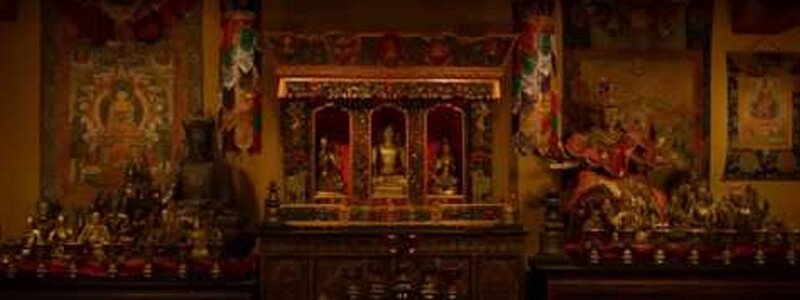The Rubin Museum of Art invites the public to explore a private collection of art from Tibet and other neighboring regions. Established by a couple with a fascination for Himalayan culture, this niche museum has some of the most precious Oriental artwork in New York City. Click to book your NYC Downtown Hop-On Hop-Off Bus Tour.
Collection and Exhibits
The permanent collection at the Rubin Museum of Art includes more than 3,800 items from multiple countries in the Himalayan region. A large percentage of the collection consists of artifacts from Tibet. You can also expect to see artwork from Nepal, China, Bhutan, and other nations that have historically been affiliated with the Tibetan Plateau.
Many of the sculptures and figures at the museum highlight the dominance of Buddhism and Hinduism in this part of the world. Silkscreens, tapestries, textiles, pottery, and paintings with religious themes dominate the collection at the Rubin Museum of Art. You’ll also see some handcrafted jewelry pieces with precious stones that are naturally found in the Himalayas.
Museum Layout
One of the most distinct features inside the Rubin Museum of Art is a spiraling staircase that was initially part of a Barneys New York store. This elegant staircase offers convenient access to multiple levels that now boast exclusive artwork from the Himalayas.
Occupying 3,850 square feet of space, the Colonnade is a premier venue for special private and public events inside the museum. The Spiral Lobby provides an additional 5,000 square feet of space for such gatherings that often gather funds for the museum.
Having a capacity for about 140 guests, a 1,400-square-foot theatre hosts film screenings and other presentations throughout the year. The Art Lounge is another great venue for intimate events.
History
In the early 1970s, Donald Rubin and his wife, Shelley, developed a deep interest in traditional Himalayan culture. The affluent couple began collecting artwork from arguably one of the most isolated and mysterious places on earth. In 1998, the pair invested more than 20 million dollars in a commercial property that was once occupied by an upscale department store.
Under the guidance of Beyer Blinder Belle Architects & Planners, the building was successfully restored and transformed into a gallery space. It took the Rubins several years to open a museum that would display their private collection of Himalayan art.
In the fall of 2004, the Rubin Museum of Art finally opened to the public and enriched the already vibrant arts scene of Manhattan. After about seven years, the Rubins donated approximately 25 million dollars to ensure that their precious institution would have a steady future. Throughout its history, the museum has been strongly affiliated with various national and local entities that provide funding. For example, the National Endowment for the Humanities and New York City Department of Cultural Affairs have gladly supported this unique museum.
Visiting Rubin Museum of Art
The Rubin Museum of Art is conveniently situated just off the busy 7th Avenue in the heart of Midtown Manhattan. Quite appropriately, this niche museum is within the bounds of the chic and Bohemian Chelsea neighborhood that has a rich tradition in the arts.
Served by the 1 and 2 lines of the New York City subway system, the 18 Street station is located just one block away from the museum. This underground station is directly linked to all major districts of Manhattan. Additional subway service is available at the 14 Street/8 Avenue station near charming Jackson Square.
You can also take a PATH train to the 23rd Street stop, which is within a 10-minute walk from the museum. Additionally, numerous Metropolitan Transportation Authority (MTA) buses navigate 7th Avenue and 6th Avenue.
If you plan to drive to the Rubin Museum of Art, you could find a parking garage on 17th Street and some other nearby streets that branch off the avenues.
Location: 150 W 17th Street, New York, NY, 10011
Click here to visit Rubin Museum of Art official website.

